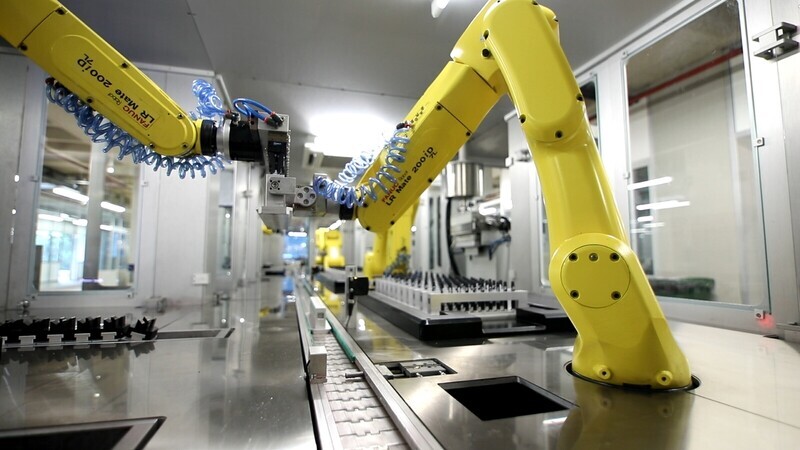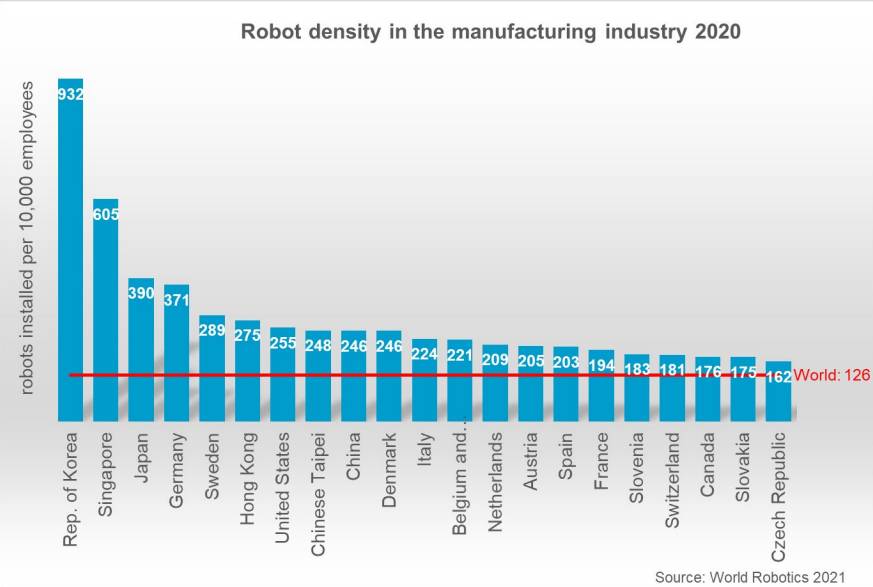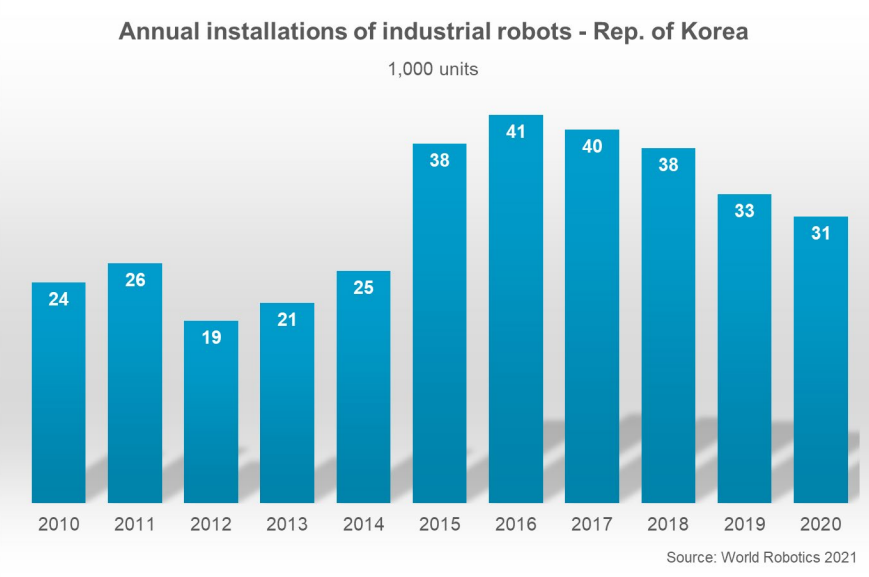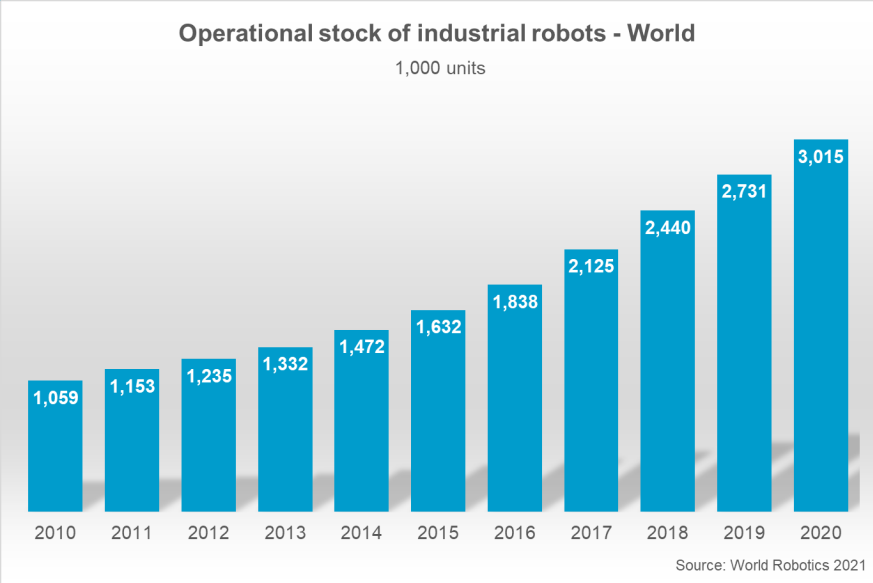hankyoreh
Links to other country sites 다른 나라 사이트 링크
S. Korea regains status as country with highest robot density

South Korea once again has the world’s highest density of robots, after three years at No. 2. Robot density is calculated as the number of robots per 10,000 members of the population. The number of industrial robots in operation around the world also topped 3 million for the first time in history.
In the World Robotics 2021 report, published on Thursday, the International Federation of Robotics (IFR) said that Korea has a robot density of 932 — the highest density in the world. That’s nearly seven and a half times the global average of 126.
That restores Korea to the No. 1 spot three years after it yielded that position to Singapore in 2018, which held the title for the next two years. Korea had boasted the world’s highest industrial robot density for the eight previous years, from 2010 to 2017.

Koreans bought 30,500 robots last year, accounting for the world’s fourth-largest market, after Japan, China and the US. Purchases were down 7% from 2019.
As of 2020, there were 342,983 industrial robots in operation in Korea. The IFR predicted that Korean demand for robots will increase 11% this year in the electronics and automotive industries and an average of 8% after that.
Singapore has been aggressively installing robots since 2016, bringing its robot density up to 918 by 2019. But density declined to 605 last year, putting Singapore back in second place. The report didn’t say why robot density had declined there, however.
Rounding off the top five countries for robot density are Japan (390), Germany (371) and Sweden (289).

According to the report, 383,500 industrial robots were installed around the world last year. That was an increase of 0.5% from 2019 — when around 382,000 new robots were rolled out — despite the COVID-19 pandemic.
The top five robot buyers — China, Japan, the US, Korea and Germany — accounted for 76% of the demand for robots around the globe.
The total number of robots working around the globe rose to over 3,014,900 by the end of 2020, the first time there have been more than 3 million robots in operation.
The average robot density around the world is 126, up 13 from last year.
Traditionally, the automotive industry has had the highest demand for industrial robots. But as the pandemic forced people to spend more time working from home and less time in public last year, the electronics industry (109,000 units) pushed aside the automotive industry (80,000 units) to become the biggest buyer of robots.

Surging demand in China drove the growth trend in the global market last year even as markets in many countries contracted, the federation noted.
The number of new installations last year was the third-highest ever, after 420,000 in 2018 and 400,000 in 2017.
Around 168,400 of the new robots, or more than 40% of the total, were installed at Chinese factories. Since 2013, China has been the world’s largest market for industrial robots. Its robot density has been steeply rising ever since, hitting 246 last year. That also sent China shooting up from 15th in 2019 to ninth place last year, the first time it has broken the top 10 in robot density.
The report predicted that China would have more than a million industrial robots by the end of this year.
While Japan is the world’s second-largest market for industrial robots, its demand for robots decreased by 23% last year, with Japanese companies buying around 38,700 units. A slowdown in Japan’s electronics and automotive industries has depressed demand for two consecutive years, following a peak of around 55,240 in 2018.
The federation predicted that 435,000 new industrial robots will be installed this year, representing an increase of 13% from last year and setting a new record. It also expects the trend to continue, leading to the installation of 500,000 new robots each year by 2024.
By Kwak No-pil, senior staff writer
Please direct questions or comments to [english@hani.co.kr]

Editorial・opinion
![[Editorial] Intensifying US-China rivalry means Seoul must address uncertainty with Beijing sooner than later [Editorial] Intensifying US-China rivalry means Seoul must address uncertainty with Beijing sooner than later](https://flexible.img.hani.co.kr/flexible/normal/500/300/imgdb/original/2024/0517/8117159322045222.jpg) [Editorial] Intensifying US-China rivalry means Seoul must address uncertainty with Beijing sooner than later
[Editorial] Intensifying US-China rivalry means Seoul must address uncertainty with Beijing sooner than later![[Column] When ‘fairness’ means hate and violence [Column] When ‘fairness’ means hate and violence](https://flexible.img.hani.co.kr/flexible/normal/500/300/imgdb/original/2024/0516/7417158465908824.jpg) [Column] When ‘fairness’ means hate and violence
[Column] When ‘fairness’ means hate and violence- [Editorial] Yoon must stop abusing authority to shield himself from investigation
- [Column] US troop withdrawal from Korea could be the Acheson Line all over
- [Column] How to win back readers who’ve turned to YouTube for news
- [Column] Welcome to the president’s pity party
- [Editorial] Korea must respond firmly to Japan’s attempt to usurp Line
- [Editorial] Transfers of prosecutors investigating Korea’s first lady send chilling message
- [Column] Will Seoul’s ties with Moscow really recover on their own?
- [Column] Samsung’s ‘lost decade’ and Lee Jae-yong’s mismatched chopsticks
Most viewed articles
- 1[Editorial] Transfers of prosecutors investigating Korea’s first lady send chilling message
- 2[Exclusive] Unearthed memo suggests Gwangju Uprising missing may have been cremated
- 3S. Korea “monitoring developments” after report of secret Chinese police station in Seoul
- 4[Editorial] Intensifying US-China rivalry means Seoul must address uncertainty with Beijing sooner t
- 5Could Korea’s Naver lose control of Line to Japan?
- 6Korea cedes No. 1 spot in overall shipbuilding competitiveness to China
- 7[Column] US troop withdrawal from Korea could be the Acheson Line all over
- 8China, Russia put foot down on US moves in Asia, ratchet up solidarity with N. Korea
- 9Xi, Putin ‘oppose acts of military intimidation’ against N. Korea by US in joint statement
- 10Korea’s first openly trans athlete hopes to prompt a discussion by competing as herself